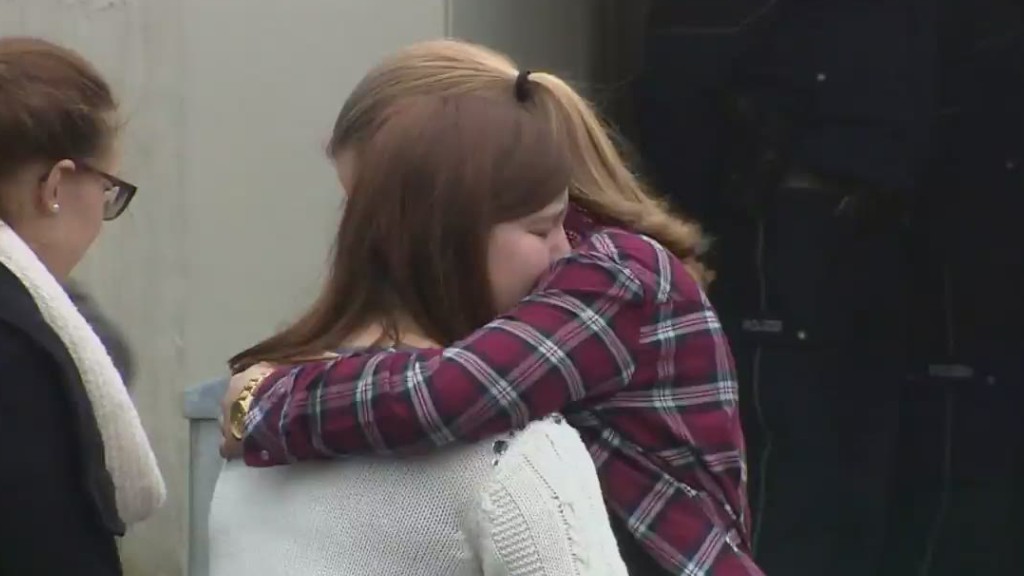On any other Wednesday morning, the steps in front of the Joseph-Koenig-Gymnasium would be packed with kids on their way to class, discussing homework, chattering about last night’s TV shows, or laying out plans for the coming weekend.
But not today.
Instead, students approached in silence, carrying photographs and flowers. In small groups, the teenagers lined up to lay tributes to their lost classmates before hugging each other wordlessly, or dissolving into tears.
At 10:53 a.m. Tuesday morning, this school in the small western German town of Haltern was changed forever by events more than 1,000 km (about 620 miles) away.
A Germanwings plane carrying 16 of its pupils and their two teachers home from a school exchange trip to Spain crashed in the French Alps, killing all of those on board.
Headmaster Ulrich Wessel said when the first reports of a crash came through he was still hopeful, thinking “perhaps they had missed the plane, or perhaps there was a second Germanwings flight at the same time.”
Instead, the worst was confirmed, leaving him “stunned and somewhat speechless,” the community devastated and the classmates of the dead struggling to understand their loss.
“A week ago Tuesday we sent 16 happy young people and two young colleagues off on a trip,” Wessel told reporters. “What was intended as a school exchange ended in tragedy.”
Of the 16 teenagers killed, 14 were girls, and two boys; one of the two female teachers who died was a newlywed.
In a post on the school’s website, Wessel and other school representatives announced the names of the dead, “who will never again return to us,” leaving all those concerned “unutterably sad.”
The teenagers who died were: Linda Bergjurgen, Elena Bless, Lea Druppel, Selina Eils, Gina Michelle Gerdes, Ann-Christin Hahn, Julia Hermann, Marleen Koch, Paula Lutkenhaus, Fabio Rogge, Rabea Scheideler, Lea Schukart, Helena Siebe, Steffen Strang, Aline Venhoff and Caja Westermann.
The two teachers were identified as Sonja Cercek and Stefanie Tegethoff.
As news of the crash spread, the area at the entrance to the school became a makeshift memorial, filled with red and white candles, notes and swiftly-painted signs.
“Yesterday we were many, today we are alone,” reads one. “Why?” demands another, with painful simplicity.
Philippa, a friend of many of those who died, told CNN she was shocked by what had happened: “I knew all of them, they were in my grade. To some I was very close.
“We had already planned things for the future, what we were going to do when they returned from their trip. It is very hard to believed that we cannot do that.”
Grief counselors, chaplains and psychologists have been brought in to the school to help all of those involved come to terms with the disaster.
“I’ve told the students and teachers that we have to accept the sorrow and grieve,” said Wessel. “I hope we will all get through it, if we share it.”
As the world’s media descend on the town, messages of support have come flooding in too.
The local newspaper is running an online book of condolence, in which people can leave messages of sympathy and “light” virtual candles to match the real ones flickering on the steps of the school.
“A silent hug says more than many words,” wrote Manuela Donovang. “Wishing the families, friends and relatives strength and comfort in the difficult days and months ahead.”
In his message, Udo Hentschel said the suffering of the parents, friends and families was “incomprehensible, unfathomable” and offered them his condolences: “This, the worst of all fates, will bind us all — friends and strangers — closer together.”
In an attempt to show that solidarity, schools across the region will share a moment of silence in memory of the dead on Friday at 10:53 a.m., the time the plane crashed.
For the classmates of those who will never return, that silence will go on, as the seats they left empty remain unfilled in the weeks and months to come.
“Our school is no longer what it once was,” said Wessel. “In Haltern we had 1,283 students. It is horrifying that now we have 16 fewer.”



